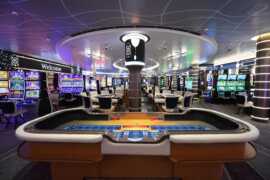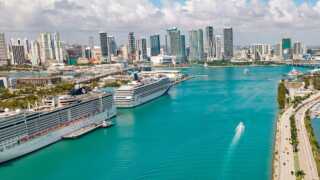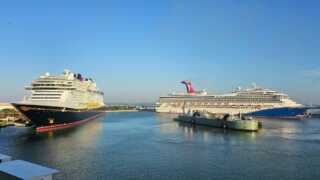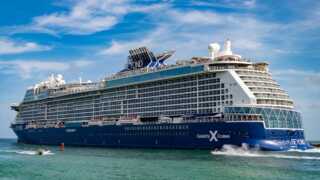Cruise lines are reshaping the role of casinos at sea, transforming them from tucked-away gaming rooms into design-led entertainment hubs that sit at the heart of the onboard experience.
Casino Royale, Harmony of the Seas
The latest refits and newbuilds across several major brands reveal an industry moving decisively to reposition casinos as high-profile social spaces aligned with contemporary cruising culture.
Royal Caribbean is leading the charge. The company recently announced that Legend of the Seas will debut a two-storey casino, a first for the line, when she enters service in 2026.
According to Royal Caribbean, the double-deck layout will include “a sweeping staircase and elevated bar overlooking the gaming floor,” with a design intended to make the casino a visual anchor for the ship rather than a peripheral space. This announcement followed September’s news that Harmony of the Seas will undergo a major refit next year, replacing its former lounge and comedy club with what the company describes as “the largest casino at sea.”
The expansion of casino spaces is part of a broader architectural shift in ship design, with public areas increasingly designed around energy and spectacle. Legend of the Seas’s two-level casino and Harmony of the Seas’s upcoming super-casino are being built in tandem with other upgrades, such as new lounges and technology enhancements.
Expanded casino area aboard Mardi Gras
Similarly, Carnival Mardi Gras, which returned to service this month following a major refit, features an overhauled casino that now forms part of the ship’s central entertainment zone. Carnival said the work was undertaken as part of an ongoing fleet-wide modernisation and “designed to elevate the guest experience through enhanced comfort and flow.”
While scale and spectacle dominate the conversation, other cruise lines are approaching the casino renaissance through refinement and atmosphere. Crystal Symphony’s recently upgraded casino has been modelled on Monte Carlo, combining European design cues with subtle luxury. Crystal Cruises said the space was redesigned to “reflect the glamour of classic gaming with a contemporary sensibility.” The approach contrasts sharply with Royal Caribbean’s expansive layouts, offering a more intimate model where lighting, materials and flow evoke the feel of a boutique hotel lounge rather than a gaming hall.
Smoking policies are also reshaping the look and feel of casino spaces. Utopia of the Seas debuted with a non-smoking casino in 2024, reflecting a significant departure from traditional cruise casino design.
Royal Caribbean said the move “responds to guest feedback and evolving preferences for clean, modern environments.” MSC Cruises has taken a similar stance, making the casinos aboard Euribia and Virtuosa entirely smoke-free. In 2023, Holland America Line announced plans to expand its casino areas and introduce non-smoking zones fleet-wide, a change it said was “in direct response to the preferences of our guests.”
Sun Princess casino
These shifts are emblematic of a wider evolution in how cruise lines interpret luxury. Where once casinos evoked exclusivity and isolation, they are now being integrated into larger entertainment districts, designed for openness and accessibility. MSC’s smoke-free policy aligns its casinos with the brand’s emphasis on sustainability and health, while Royal Caribbean’s focus on scale and spectacle ties the casino experience to its identity as a leader in high-energy entertainment.
Princess Cruises has taken a similar approach. Sun Princess, delivered this year, features the largest casino in the fleet, with hundreds of slot machines and a dedicated high-limit area. Princess said the space had been designed to “blend seamlessly with adjacent entertainment venues,” signalling a continued push to make casinos integral to the social flow of the ship.
On Wonder of the Seas, Royal Caribbean relocated its Crown Lounge to expand the casino floor, a change that reflects how lines are reconfiguring existing layouts to prioritise gaming as both an entertainment and revenue driver.
This trend sits squarely within what some shipbuilders describe as the “refit era”, a strategic shift toward renewing existing tonnage rather than relying solely on newbuilds. The refurbishment of Carnival Mardi Gras encapsulates this philosophy. While the ship’s updated casino is one of the most visible changes, it forms part of a larger overhaul encompassing technology, accommodation, and dining.
Across the industry, casino refurbishments are increasingly included in these large-scale renewal programmes, underscoring their commercial and aesthetic importance.
Together, these developments mark a decisive redefinition of what a cruise casino represents. Once designed for a niche clientele, the casino is now being positioned as a versatile social environment that is clean, architectural, and connected to the wider passenger experience. Whether inspired by the grandeur of Monte Carlo or by the immersive spectacle of a double-deck gaming hall, the modern cruise casino embodies how lines are balancing tradition with innovation.
In the process, the casino has become a microcosm of the cruise industry’s wider evolution: embracing design-driven environments, responding to new health and lifestyle expectations, and reinventing legacy spaces for a new generation of travellers.
Related
Appeared first on: Cruisearabiaonline.com





